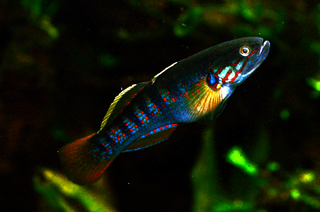
Eleotridae is a family of fish commonly known as sleeper gobies, with about 34 genera and 180 species. Most species are found in the tropical Indo-Pacific region, but there are also species in subtropical and temperate regions, warmer parts of the Americas and near the Atlantic coast in Africa. While many eleotrids pass through a planktonic stage in the sea and some spend their entire lives in the sea; as adults, the majority live in freshwater streams and brackish water. One of its genera, Caecieleotris, is troglobitic. They are especially important as predators in the freshwater stream ecosystems on oceanic islands such as New Zealand and Hawaii that otherwise lack the predatory fish families typical of nearby continents, such as catfish. Anatomically, they are similar to the gobies (Gobiidae), though unlike the majority of gobies, they do not have a pelvic sucker.
Pascua is a genus of gobies native to the Pacific Ocean. The origin of the name "Pascua" is from the Spanish for "Easter" in recognition of the Easter Island range of the type specimen.

Glossogobius is a genus of gobies native to fresh, brackish and marine waters from Africa to the coasts of the western Pacific Ocean. They are found in Madagascar, South Africa, Japan, Thailand, Australia, Indonesia, Bangladesh, the Philippines, Taiwan, Papua New Guinea, Singapore, Malawi, Swaziland, Botswana, Kenya, Zimbabwe, Tanzania, Mozambique, the Solomon Islands, Palau, Fiji, New Caledonia, India, Laos, Sri Lanka, Myanmar, Borneo, Nepal, Brunei Darussalam, Micronesia, Cambodia, Viet Nam, China, Réunion, the Seychelles, Mauritius, the Caroline Islands, Vanuatu, Malaysia and Russia. The genus also includes a troglobitic species, G. ankaranensis.

Mugilogobius is a genus of fish in the family Gobiidae. They are found in fresh, brackish and marine water of the Indo-Pacific region. Several of the freshwater species have highly restricted distributions.

Cryptocentrus also known as Watchman gobies, and one of the genera known as shrimp gobies or prawn gobies, is a genus of gobies native to tropical marine waters of the Indian and Pacific oceans.
Barbulifer is a genus of gobies native to the tropical Atlantic coast of the Americas as well as the Gulf of California on the Pacific coast.
Egglestonichthys is a genus of gobies native to brackish and marine waters of the Indian Ocean and the western Pacific Ocean.
Hetereleotris is a genus of gobies native to the western Indian Ocean and the western Pacific Ocean.

Istigobius is a genus of gobies found in fresh, brackish and marine waters of the regions along the coasts of the Indian and western Pacific oceans.

Psammogobius is a genus of fish in the family Gobiidae found in the Atlantic, Indian and Pacific Ocean.

Stonogobiops is a genus of gobies native to the Indian and Pacific oceans. This is one of the "shrimp goby" genera, the members of these genera being commensal with various species of shrimps.
Sueviota is a genus of fish in the family Gobiidae native to the Indian and Pacific Ocean.

Tryssogobius is a genus of small gobies native to the western Pacific Ocean. The species in this genus are known colloquially as "fairygobies".

Fusigobius signipinnis, commonly called flasher sandgoby or signal goby among various vernacular names, is a species of marine fish in the family Gobiidae.

Parioglossus is a genus of dartfishes native to the Indian and Pacific oceans.

Ptereleotris is a genus of dartfishes found in the Atlantic, Indian and Pacific oceans.
Gnatholepis gymnocara, the Nakedcheek sandgoby, is a small species of ray-finned fish in the subfamily Gobionellinae. The Naked cheek sandgoby is found primarily in the Indian Ocean along the coast of Australia.

Istigobius ornatus, the Ornate goby, is a species of gobies found in the Indo-Pacific.

Thalasseleotris is a genus of gobies comprising two species in the family Thalasseleotrididae from the south-western Pacific Ocean in the seas off Australia and New Zealand. The generic name is derived from the Greek Thalassa meaning "sea" and the generic name Eleotris as at the time it was named the genus was considered to be in the family Eleotridae.
Helen K. Larson is an ichthyologist who specialises in the fishes of the Indo-Pacific.













